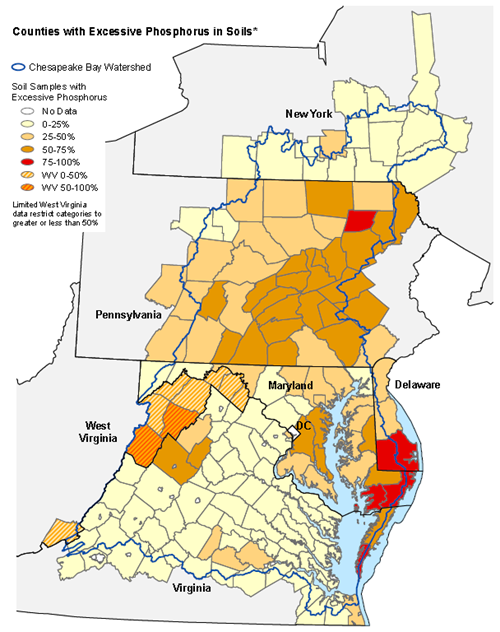Phosphorus pollution from farms causing Chesapeake Bay dead zones
CONTACT: Contact EWG Public Affairs 202-667-6982
12-07-2010
WASHINGTON – For more than thirty years, contamination from high-intensity farming has been adding to the pollution that fouls Chesapeake Bay, one of America’s most storied waterways. A new report from the Environmental Working Group (EWG) shows that weakly regulated agricultural practices in the six states of the Chesapeake watershed are overloading soils with phosphorus, a major reason the bay is in trouble. EWG’s Bay Out of Balance [pdf] report finds that in 20 percent of the counties in the watershed, more than half of the soils tested contain far more phosphorus than crops can use. Once soil gets overloaded with phosphorus from manure or fertilizer, it becomes a persistent source of pollution, sometimes for decades. “The system we use to prevent phosphorus pollution in the Chesapeake Bay is broken,” said Rebecca Sutton, Ph.D., lead author of the report. “Past efforts have clearly failed to stem the pollution flowing from farm fields to the bay,” said Sutton. “We have been more worried about finding places to dispose of manure than about protecting the bay.” Sutton makes several recommendations for fixing the problem in Bay Out of Balance, including:
- The watershed states must implement uniform definitions and standards for optimum and excessive soil phosphorus levels in order to protect water quality.
- The six states need to accurately collect and assess soil test data on phosphorus levels.
- A strict science-based limit above which phosphorus should never be applied to fields must be developed and implemented by all Bay states.
“One of most important things we can do to clean up Chesapeake Bay is ensure that farms add only the phosphorus that plants need to thrive, rather than as much phosphorus as soils can absorb before spilling it into local waterways. We need to regard phosphorus as a potential pollutant, ensure that farmers don’t over-fertilize and find non-polluting ways to dispose of excess manure,” Sutton said. The Environmental Protection Agency (EPA) is working with the bay watershed states to develop a Total Maximum Daily Load (TMDL) standard that will set the maximum amount of pollutants that Chesapeake Bay and its tidal tributaries can accept without violating water quality standards. To read Bay Out of Balance, go to: http://www.ewg.org/report/bay-out-of-balance.
Farm Pollution Knocks Chesapeake Bay Out of Balance
